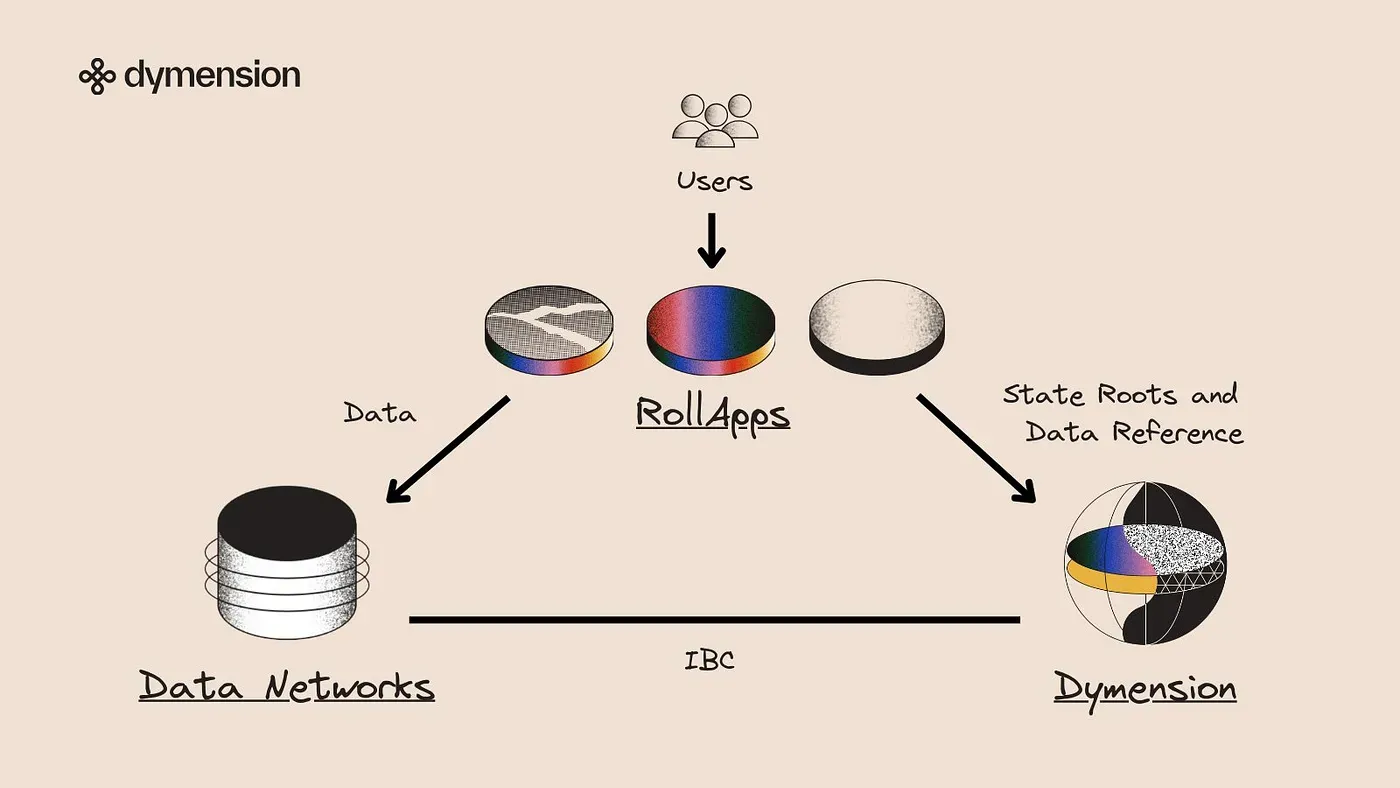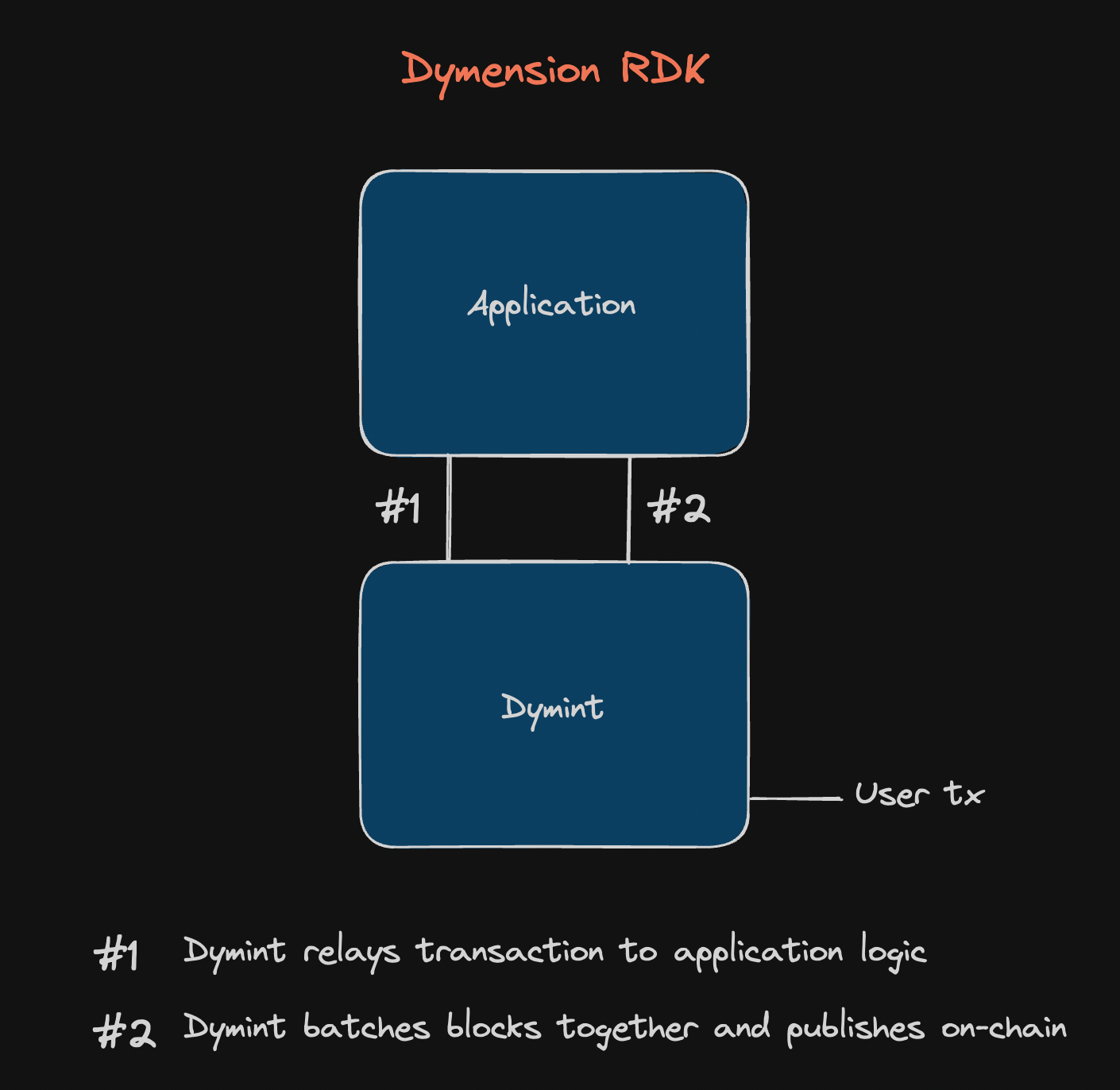What is Dymension? What are the challenges around the old-fashioned monolithic blockchain architectures? And how does Dymension address those challenges?
Dymension is a Delegated Proof of Stake (DPoS) blockchain first introduced in 2022 to address some of the pressing challenges around the so-called monolithic blockchain architecture.
An Overview of Modular and Monolithic Blockchain Architectures
The monolithic blockchain approach used to be the dominant approach in building blockchains. This means a single blockchain was responsible for every aspect of its operations - processing transactions, ensuring consensus, managing data availability, and executing contracts.
This approach faced significant scaling challenges, including high hardware requirements, complex validator bootstrapping, and limited application flexibility.
Modular blockchains, in contrast, adopt a more regimented approach. They split the various functions of a blockchain into distinct components, each specializing in a specific function. This division allows for greater efficiency and scalability.
Modular blockchains can easily accommodate the following functions:
- Execution: Handling the processing of transactions
- Settlement: Managing dispute resolution and serving as a bridge when needed
- Consensus: Ordering transactions and achieving agreement across the network
- Data Availability: Ensuring that data is accessible and reliable.
An example of this modular approach is so-called rollups, which focus on execution and delegating other tasks like consensus and data availability to other specialized modular blockchains.
The key advantages that modular blockchains offer over monolithic ones are:
- Scalability: Modular blockchains can handle more transactions more efficiently by distributing tasks across multiple specialized chains.
- Customizability: Different blockchain components can be tailored to specific needs, offering flexibility for different applications.
- Lower Hardware Requirements: Since functions are distributed, the hardware burden on individual nodes is reduced, making it easier for more participants to join the network.
What is Dymension?
Dymension is an application-specific blockchain (app chain) where the main application of the app chain is to support rollups.
This support is achieved through the settlement layer, also known as the "Dymension Hub," a Cosmos SDK PoS chain that enables so-called enshrined rollups.
Initially, smart contract developers could only deploy contracts on top of L1 blockchains like Ethereum however this meant sacrificing scalability for security.
To address the scalability problem, the blockchain community of developers and builders started introducing rollups instead of new L1 chains. This enabled a better compromise between scalability and security but introduced yet another new issue around customizability.
When you deploy a dApp on a rollup, you also share computational resources with all the existing dApps. This can lead to a battle for already limited block space and gas.
When we look at this aspect of customizability, dApps have to follow strict rules and underlying frameworks to the chains in which they are deployed. These issues compounded amongst each other have led to the creation of app chains popularized by Cosmos, Polygon, and others.

Dymension takes this one step further through the introduction of so-called RollApps. Not only are developers getting all the benefits of security properties from a proven chain like Cosmos through a rollup, but they are also getting greater customization by having their dedicated environments.
The Technical Architecture Behind Dymension
Dymension introduces an innovative approach to blockchain design, emphasizing modularity and scalability. Under monolithic architectures, everything from transaction settlement to data processing is settled on a single blockchain. In Dymension, each application contains its execution environment, and the Dymension Hub is the settlement layer.
The architecture of Dymension can be broken down into its specific layers: the Execution, Settlement, and Data Availability Layer.
Execution Layer
An application deployed on Dymension functions as an autonomous execution environment called a RollApp.
RollApps are application-specific rollups focusing on execution while offloading consensus overhead, leading to a scalable environment. RollApps uses Dymension Hub's shared security framework to protect and interconnect other IBC-enabled chains, enhancing network effects.
RollApps have autonomy, meaning each RollApp maintains its token for network fees, possesses fully flexible application logic, and ensures trust-minimized interoperability with other RollApps and IBC-enabled blockchains. RollApps operate on a fraud-proof design and only one so-called honest participant is needed to ensure system integrity.
Settlement Layer
The Dymension Settlement layer, or the Hub, is a Cosmos SDK PoS chain that uses the Tendermint Core for networking and consensus.
The Hub differs from monolithic blockchains as it is specifically designed to optimize rollup services. The Dymension Hub integrates rollup servicing logic, facilitating native interoperability among RollApps.
This process is referred to as being “enshrined” since the Dymension Hub is specifically designed to integrate and maintain RollApps, providing high security.
This approach is distinct from other non-enshrined solutions that rely on multi-signature bridges, offering a unique and secure framework for RollApps within the Dymension ecosystem.
Data Availability Layer
The Dymension protocol segregates responsibilities to alleviate data bottlenecks and achieve scalability. The protocol includes a Data Availability (DA) layer, allowing verification of state transitions as reported by the RollApp Sequencer. RollApps in Dymension can integrate various DA providers tailored to specific security and cost needs.
A vital aspect of this system is defining checkpoints as block batches in the DA layer, with corresponding state roots in the settlement layer, ensuring data integrity and consistency across RollApp nodes.
This careful selection of a DA solution is critical for RollApp deployment, as corrupted data can lead to state discrepancies.
Under this system, only one actor needs to submit fraud proof and prove that a malicious action was committed by the RollApp sequencer, and if so, the sequencer will end up getting slashed.
The RollApps Ecosystem
The RollApps ecosystem currently consists of several types of rollup services that app chains can take advantage of.
Those services/frameworks are RollApp SDK, Rollup as a service (RaaS), Rollup SDK as a Service, and Shared Sequencing Networks.
Let's go over these types of RollApps in further detail and discuss Dymension's specific form in this spectrum of RollApps.
RollApp SDK
RollApp SDK is a framework and toolkit designed to help developers create custom rollups easily. Developers need a basic understanding of blockchain logic to develop their application-specific rollups. Various SDKs are available, each focusing on different types of rollups and offering various options for validity and fraud proofs.
Rollup as a service (RaaS)
RaaS pertains to service providers that create services using a Rollup SDK, such as Caldera utilizing the OP stack, to facilitate rollup deployment without requiring users to manage code or nodes/calls, which RaaS operators handle.
This simplifies the development experience for smart contract developers, as they don't need to grasp the underlying blockchain logic, closely mirroring the smart contract development process.
Rollup SDK as a Service
RaaS is directed at smart contract developers directly to consumers, highlighting a need for a service consolidating various SDKs for developers. This has led to a B2B service model called Rollup SDK as a service.
Shared Sequencing Networks
Despite individual RaaS or RollApp SDKs potentially having their sequencers, there's a demand for specialized sequencer providers focused on the consensus and security of decentralized sequencer networks. A shared sequencer network could make it easier to achieve atomicity and interoperability among various RollApps.
Dymension’s Role in the RollApps Ecosystem
Dymension is creating a unique rollup ecosystem characterized by so-called enshrinement, which integrates rollups closely with the base layer's trust and security while offering a simpler, safer, and more efficient framework for development.
Unlike solutions primarily targeting the EVM, Dymension aims to facilitate vertical scaling within the Cosmos ecosystem. This approach, though possibly less flexible and sovereign, brings significant benefits to the Dymension Hub, including:
- Shared Security: The Dymension Hub uses a shared security model that grows stronger as more RollApps are deployed. Deploying a RollApp requires bonding DYM tokens to network validators, enhancing security through increased stakes. The system is designed so that overtaking the Dymension chain would require acquiring two-thirds of all staked DY BnB M; thus, as more rollups are deployed, the network's security increases due to the higher cost of achieving such control.
- Inter-connectivity: Central to the Dymension ecosystem is the Inter Rollup Communication (IRC) protocol, a modified version of the Inter-Blockchain Communication (IBC) protocol tailored for rollups. This enables efficient rollup-to-rollup bridging and interoperability, leveraging the Dymension hub as a nexus. With the IBC-enabled Hub, RollApps can interact with other IBC-compatible app chains, like Osmosis and Juno, facilitating a broad spectrum of interoperability within the Cosmos ecosystem.
Integrating enshrined rollups into Ethereum poses challenges, leading projects like Dymension to opt for the Cosmos ecosystem. As we can glean, a significant drawback of enshrined rollup SDKs is their limited flexibility and sovereignty.
The core mechanisms of block production, proof verification, and rollup types are fixed within the settlement layer, restricting the developer’s ability to modify or customize these aspects freely through Dymension’s RollApp Development Kit (RDK) framework.

Final Thoughts
Dymension is pioneering an advanced ecosystem for RollApps within the Cosmos network, focusing on overcoming the constraints of traditional blockchain designs. With its unique architecture, Dymension facilitates the creation of autonomous execution environments, offering significant scalability and interoperability benefits.
As Dymension celebrates its mainnet launch, it aims to redefine app chain development by providing a more scalable, secure, and interconnected ecosystem for developers in the Cosmos network and beyond.


Join the conversation